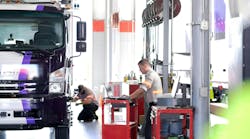Autonomous is the big buzzword in the trucking industry these days, and for good reason. The idea of trucks safely driving themselves is futuristically cool and fun to envision, even if its reality isn’t much past toddler-steps development.
While there are steady gains being made to that end, fleets today have available already-perfected commercial safety systems products that are pretty sweet in their own right, with more on the horizon.
Brian Daniels, manager of powertrain and component product marketing for the Detroit brand of Daimler Trucks North America, provided a comprehensive overview of just such advancements at the recent annual meeting of the Technology & Maintenance Council (TMC) in Atlanta.
This is part 3 in a continuing Fleet Owner series spotlighting speakers and topics from the safety systems seminar there (read Part 1 and Part 2).
Panel moderator and Meritor national account manager Jack Vander Giessen began the event by putting autonomous vehicle progress into perspective.
“We’ll start with where we’re at with the five levels of automation,” he told the audience of 400-plus people. “This is sourced from SAE (Society of Automotive Engineers). As we look at the levels of vehicle autonomy, which are from no automation at all up to fully self-driving, I think the general consensus is that we’re about at level two right now (driver assistance) and progressing.”
He then turned the proceedings over to the panelists.
“100% of you have a collision mitigation system on your trucks, and that collision mitigation system is your driver,” Daniels asserted. “What collision mitigation systems and safety systems are meant to do is supplement the driver as the key number one safety system.”
As such, the Detroit Assurance safety system, he noted, has reached close to 75% sale rate for all new Freightliner trucks ordered.
“When we started in 2015 with our product it was primarily a collision mitigation system,” said Daniels. “About how to avoid that vehicle (in front) in a hard-braking event, an emergency event. Then you look at where we are now, and where things are headed. Now it’s not just about safety of the collision mitigation system, it’s also about safety in reducing driver fatigue, with adaptive cruise control technology. We follow the vehicle in front. As that vehicle slows down, we slow down. As it speeds up, we speed up.”
Daniels detailed some of the specific safety systems that Detroit Assurance has incorporated, and others it will shortly incorporate, with its 5.0 version expected this September.
Active lane assist: “If I start to depart the lane I will get a little chirp to tell me to come back in my lane,” he said. “If the driver does not make that corrective behavior, the steering on the truck will actively steer the vehicle back in that lane. The second part of the technology is lane-keep assist. It uses cameras on both sides of the lane to keep the vehicle perfectly centered down the road.
“A yellow caution means (the safety system) sees some object… a person, pole, or car in our presence,” he said. “If we give steering input or a turn signal that warning goes to red and sounds an audible alert.”
Traffic sign display: “For when we’re driving for a long period of time and forget what the road speed is,” Daniels explained. “It tells the driver what signs he may have missed, like road speed signs; always giving the driver heads-up feedback.”
Intelligent high beams: “The idea here being that when we’re driving in a very dark area and don’t see brake lights or tail lights, we can turn on our high beams,” he said. “As soon as we come into contact with bright lights, tail lights or city lights (the safety system will) dim the high beams.
“Same thing with auto wipers and auto headlamps. The (safety system has the) ability to turn those features on if we’re in dark or dusk or raining situations.”
Side guard assist and side-mounted radar: “It is looking for pedestrians and bicyclists, and also, when the truck and trailer is turning, it will predict if the truck could come into contact with a pole or something else,” said Daniels.
Acknowledging that there are often situations when the driver must make decisions regardless of what the safety systems suggest, Daniels said that has been taken into account, with options available.
“What happens in a construction zone or when you have to drive over marked lines?” he asked. “You don’t want to have to fight the safety system. We have a lane keep assist and lane departure warning off switch. Lane keep assist is an on/off. Lane departure warning is a 15-minute on/off switch. These are good things to know from a driver coaching perspective.”
Daniels related that even professional drivers sometimes have their hands off the wheel. The new safety system addresses that.
“What happens if the driver for whatever reason decides not to keep his hands on the wheel?” he pondered. “After 15 seconds he’s going to get a visual hands-on warning along with a visual and audible alert. After 30 seconds it’s a red warning and the frequency increases until they put their hands back on the wheel.”
Finally, Daniels explained that coaching drivers and making sure they understand the systems in their trucks is imperative.
“There are multiple versions of safety systems, and how in the world as a driver am I supposed to know what I’m driving and how I’m supposed to drive it?” he asked. “We’ve put in place a VIN lookup tool. It will tell them what (safety system) features they have (on the truck), and there is a 45- to 60-second video that shows how the features work. That’s part of the acceptance, and important for driver comfort.”



